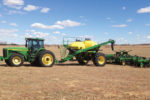Advertise Follow Us
Articles Tagged with ''Wheat''
Cover Crop Pioneer Tweaks His Formula For Success
Switching to no-till and adding cover-crop mixes and finely tuned equipment helped Joe Swanson emerge from the farm crisis and find a new path to profitability.
Read More
What I've Learned from No-Tilling
Breaking Through the No-Till Barrier with Cover Crops
Adding winter wheat, livestock and cover crops helped Paul Ackley overcome his no-till plateau, simplify his planter and build more productive soils.
Read More







